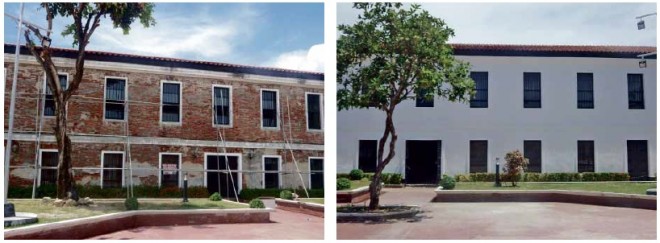Restoration work in historic Fort Pilar raises furor

WHITE WALLS in Zamboanga City’s Fort Pilar as part of renovation work. Photos from Facebook account of Councilor Vincent Paul Elago
ZAMBOANGA CITY, Philippines—A project of the National Museum to restore a building at historic Fort Pilar here has raised a furor among netizens, who said the agency had tampered with the way the structure looked.
The original brick-covered facade on the inner south and east walls has been plastered and painted white.
Residents took notice of how the renovation project went since it was started in the 1980s. Netizens took to social media sites to vent their ire on the National Museum and the local government.
Fort Pilar, a revered site in Zamboanga peninsula, was built by the Spanish colonial government as a defense fortress against pirates. Spanish Gov. Juan Cerezo de Salamanca approved the construction of the fort in 1635.
The city celebrates the Hermosa Festival highlighting the historical role of the fort.
Fort Pilar was recognized a national cultural treasure on Aug. 1, 1973, through Presidential Decree No. 260.
Councilor Vincent Paul Elago, chair of the tourism committee, posted on his Facebook account that the project had become “a crime against the heritage of Zamboanga.”
One Facebook user slammed the “desecration of the Fort.”
Another said the fort looked like a “white house,” while still another described it to “look like a prison.”
One netizen questioned why the National Museum was able to implement the changes without the knowledge of local government officials.
“While people are doing nasty things inside the ‘fortaleza,’ no one from the city government was checking on them,” lamented one Facebook user.
Mayor Beng Climaco-Salazar, however, yesterday inspected the ongoing restoration and scheduled a dialogue with the National Museum on Thursday to get a clarification from the agency, according to Elago.
“The whole city council is enraged … there is no record of any transmission of information from the National Museum regarding renovation works at the fort,” Elago said.
Ivan Henares, the president of Heritage Conservation Society, which advocates restoration, has defended the project. “I support what the National Museum is doing. That is proper restoration,” he posted a comment on Facebook.
Henares explained that the white “paletada” was not cement and was needed to protect the bricks. “It’s a beautiful military white paletada. Really lovely!” he said.
“Filipinos have this wrong impression that restoring means making it look old. Restoring means bringing it back as close as possible to its original state, using methods and materials that approximate the original,” he said.
Henares said the Zamboangueños should even be proud of Fort Pilar for being chosen as a recipient of the restoration project.
“That the National Museum chose Zamboanga for world-class restoration is something the locals should be proud about,” he said.
“They will make the Fort Pilar restoration the model for what they plan in Fort San Pedro in Cebu and the reconstructed Fort Nuestra Señora del Rosario in Iloilo, as well as their plan to restore the Palawan forts. And that’s just the structure,” he added.
In another post, Henares cited National Museum Jeremy Barns in calling the project a “world-class restoration,” given the importance of the fort in Philippine history.
“According to Director Jeremy Barns, he promised world-class restoration because Fort Pilar, properly restored, is the reference point that places Zamboanga in its historic-cultural context with the rest of the archipelago and throughout the Spanish world,” Henares said.
“We know the reaction is harsh. But we need to level up to world-class standards and show Filipinos what proper restoration looks like,” he added.
Based on the plan, the building will have air-conditioned galleries, a shop, café, conference rooms for educational activities and will have Wi-Fi connection.
The project prospective posted outside the museum showed that the National Museum has contracted FJ Construction & Enterprises to carry out the “expansion” and “upgrading” of the fort. Liza Jocson, Inquirer Mindanao, and Penelope P. Endozo in Manila